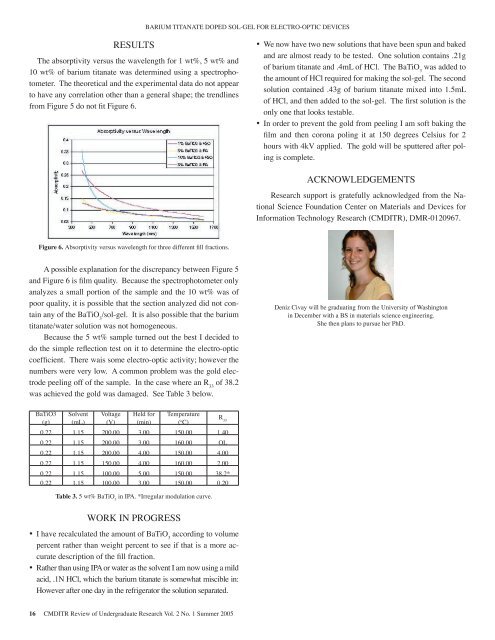Student Project Abstracts 2005 - Pluto - University of Washington
Student Project Abstracts 2005 - Pluto - University of Washington
Student Project Abstracts 2005 - Pluto - University of Washington
You also want an ePaper? Increase the reach of your titles
YUMPU automatically turns print PDFs into web optimized ePapers that Google loves.
BARIUM TITANATE DOPED SOL-GEL FOR ELECTRO-OPTIC DEVICESRESULTSThe absorptivity versus the wavelength for 1 wt%, 5 wt% and10 wt% <strong>of</strong> barium titanate was determined using a spectrophotometer.The theoretical and the experimental data do not appearto have any correlation other than a general shape; the trendlinesfrom Figure 5 do not fit Figure 6.• We now have two new solutions that have been spun and bakedand are almost ready to be tested. One solution contains .21g<strong>of</strong> barium titanate and .4mL <strong>of</strong> HCl. The BaTiO 3was added tothe amount <strong>of</strong> HCl required for making the sol-gel. The secondsolution contained .43g <strong>of</strong> barium titanate mixed into 1.5mL<strong>of</strong> HCl, and then added to the sol-gel. The first solution is theonly one that looks testable.• In order to prevent the gold from peeling I am s<strong>of</strong>t baking thefilm and then corona poling it at 150 degrees Celsius for 2hours with 4kV applied. The gold will be sputtered after polingis complete.ACKNOWLEDGEMENTSResearch support is gratefully acknowledged from the NationalScience Foundation Center on Materials and Devices forInformation Technology Research (CMDITR), DMR-0120967.Figure 6. Absorptivity versus wavelength for three different fill fractions.A possible explanation for the discrepancy between Figure 5and Figure 6 is film quality. Because the spectrophotometer onlyanalyzes a small portion <strong>of</strong> the sample and the 10 wt% was <strong>of</strong>poor quality, it is possible that the section analyzed did not containany <strong>of</strong> the BaTiO 3/sol-gel. It is also possible that the bariumtitanate/water solution was not homogeneous.Because the 5 wt% sample turned out the best I decided todo the simple reflection test on it to determine the electro-opticcoefficient. There wais some electro-optic activity; however thenumbers were very low. A common problem was the gold electrodepeeling <strong>of</strong>f <strong>of</strong> the sample. In the case where an R 33<strong>of</strong> 38.2was achieved the gold was damaged. See Table 3 below.Deniz Civay will be graduating from the <strong>University</strong> <strong>of</strong> <strong>Washington</strong>in December with a BS in materials science engineering.She then plans to pursue her PhD.BaTiO3(g)Solvent(mL)Voltage(V)Held for(min)Temperature( o C)0.22 1.15 200.00 3.00 150.00 1.400.22 1.15 200.00 3.00 160.00 OL0.22 1.15 200.00 4.00 150.00 4.000.22 1.15 150.00 4.00 160.00 2.000.22 1.15 100.00 5.00 150.00 38.2*0.22 1.15 100.00 3.00 150.00 0.20Table 3. 5 wt% BaTiO 3in IPA. *Irregular modulation curve.R 33WORK IN PROGRESS• I have recalculated the amount <strong>of</strong> BaTiO 3according to volumepercent rather than weight percent to see if that is a more accuratedescription <strong>of</strong> the fill fraction.• Rather than using IPA or water as the solvent I am now using a mildacid, .1N HCl, which the barium titanate is somewhat miscible in:However after one day in the refrigerator the solution separated.16 CMDITR Review <strong>of</strong> Undergraduate Research Vol. 2 No. 1 Summer <strong>2005</strong>




